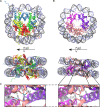Archaeal chromatin 'slinkies' are inherently dynamic complexes with deflected DNA wrapping pathways
- PMID: 33650488
- PMCID: PMC7990501
- DOI: 10.7554/eLife.65587
Archaeal chromatin 'slinkies' are inherently dynamic complexes with deflected DNA wrapping pathways
Abstract
Eukaryotes and many archaea package their DNA with histones. While the four eukaryotic histones wrap ~147 DNA base pairs into nucleosomes, archaeal histones form 'nucleosome-like' complexes that continuously wind between 60 and 500 base pairs of DNA ('archaeasomes'), suggested by crystal contacts and analysis of cellular chromatin. Solution structures of large archaeasomes (>90 DNA base pairs) have never been directly observed. Here, we utilize molecular dynamics simulations, analytical ultracentrifugation, and cryoEM to structurally characterize the solution state of archaeasomes on longer DNA. Simulations reveal dynamics of increased accessibility without disruption of DNA-binding or tetramerization interfaces. Mg2+ concentration influences compaction, and cryoEM densities illustrate that DNA is wrapped in consecutive substates arranged 90o out-of-plane with one another. Without ATP-dependent remodelers, archaea may leverage these inherent dynamics to balance chromatin packing and accessibility.
Keywords: AUC; archaea; chromosomes; cryo-EM; gene expression; histone; molecular biophysics; molecular dynamics; none; nucleosome; structural biology.
Plain language summary
All animals, plants and fungi belong to a group of living organisms called eukaryotes. The two other groups are bacteria and archaea, which include unicellular, microscopic organisms. All three groups have genes, which are typically stored on long strands of DNA. Eukaryotes have so much DNA that they use proteins called histones to help package and organize it inside each cell. Archaea also have simplified histones that help store their DNA, and studying these proteins could reveal how eukaryotic histones first evolved. In eukaryotes, groups of eight histones form a short cylinder that organizes a small section of DNA into a structure called a nucleosome. Each cell needs hundreds of thousands of nucleosomes to arrange its DNA. Eukaryotic cells also contain other proteins that release pieces of DNA from histones so that their genetic information can be used. The histones in Archaea don’t form discrete nucleosomes, instead, they coil DNA into ‘slinky-like’ shapes. It’s still unclear how DNA packing in archaea works and how it differs from eukaryotes. Bowerman, Wereszczynski and Luger used computer simulations, biochemistry and cryo-electron microscopy to study the histones from archaea. The archaeal ‘slinky-like’ histone structures are more flexible than nucleosomes, and can open and close like clamshells. This flexibility allows the information in the genomes of Archaea to be easily accessed, so, unlike in eukaryotes, archaeal cells may not need other proteins to release the DNA from the histones. The ability to package DNA allows cells to contain many more genes, so evolving histones was a vital step in the evolution of eukaryotic life, including the appearance of animals. Archaeal histones may reflect early versions of histones in eukaryotes, and can be used to understand how DNA packing has evolved. Furthermore, a greater understanding of Archaea may help better explain their role in health and global ecosystems, and allow their use in industrial applications.
© 2021, Bowerman et al.
Conflict of interest statement
SB, JW, KL No competing interests declared
Figures











Similar articles
-
Archaeal nucleosome positioning in vivo and in vitro is directed by primary sequence motifs.BMC Genomics. 2013 Jun 10;14:391. doi: 10.1186/1471-2164-14-391. BMC Genomics. 2013. PMID: 23758892 Free PMC article.
-
Archaeal DNA on the histone merry-go-round.FEBS J. 2018 Sep;285(17):3168-3174. doi: 10.1111/febs.14495. Epub 2018 Jun 15. FEBS J. 2018. PMID: 29729078 Review.
-
The Hypersaline Archaeal Histones HpyA and HstA Are DNA Binding Proteins That Defy Categorization According to Commonly Used Functional Criteria.mBio. 2023 Apr 25;14(2):e0344922. doi: 10.1128/mbio.03449-22. Epub 2023 Feb 13. mBio. 2023. PMID: 36779711 Free PMC article.
-
Archaeal histone selection of nucleosome positioning sequences and the procaryotic origin of histone-dependent genome evolution.J Mol Biol. 2000 Oct 13;303(1):25-34. doi: 10.1006/jmbi.2000.4128. J Mol Biol. 2000. PMID: 11021967
-
Histones and nucleosomes in Archaea and Eukarya: a comparative analysis.Extremophiles. 1998 Aug;2(3):141-8. doi: 10.1007/s007920050053. Extremophiles. 1998. PMID: 9783158 Review.
Cited by
-
The chromatin landscape of the euryarchaeon Haloferax volcanii.Genome Biol. 2023 Nov 6;24(1):253. doi: 10.1186/s13059-023-03095-5. Genome Biol. 2023. PMID: 37932847 Free PMC article.
-
Profile of Karolin Luger.Proc Natl Acad Sci U S A. 2022 Aug 23;119(34):e2212317119. doi: 10.1073/pnas.2212317119. Epub 2022 Aug 8. Proc Natl Acad Sci U S A. 2022. PMID: 35939715 Free PMC article. No abstract available.
-
Nanoscale analysis of human G1 and metaphase chromatin in situ.EMBO J. 2025 May;44(9):2658-2694. doi: 10.1038/s44318-025-00407-2. Epub 2025 Mar 17. EMBO J. 2025. PMID: 40097852 Free PMC article.
-
Histones with an unconventional DNA-binding mode in vitro are major chromatin constituents in the bacterium Bdellovibrio bacteriovorus.Nat Microbiol. 2023 Nov;8(11):2006-2019. doi: 10.1038/s41564-023-01492-x. Epub 2023 Oct 9. Nat Microbiol. 2023. PMID: 37814071 Free PMC article.
-
Columnar structure of human telomeric chromatin.Nature. 2022 Sep;609(7929):1048-1055. doi: 10.1038/s41586-022-05236-5. Epub 2022 Sep 14. Nature. 2022. PMID: 36104563
References
Publication types
MeSH terms
Substances
Grants and funding
LinkOut - more resources
Full Text Sources
Other Literature Sources

